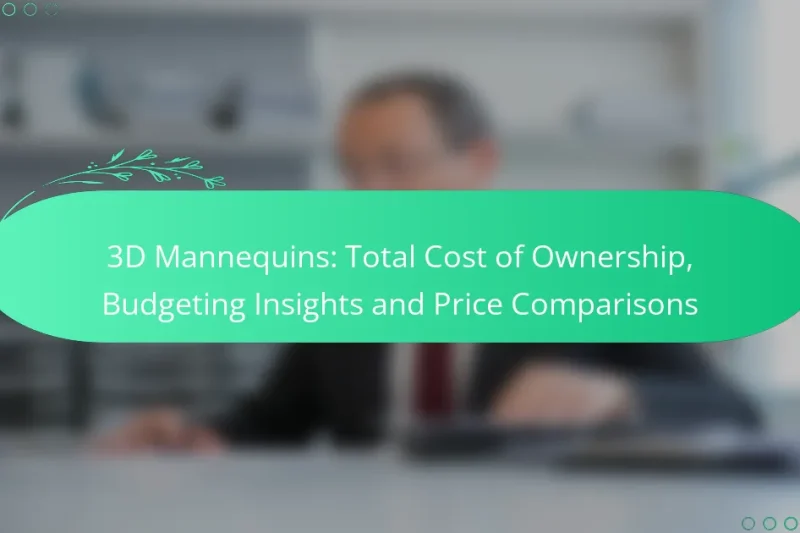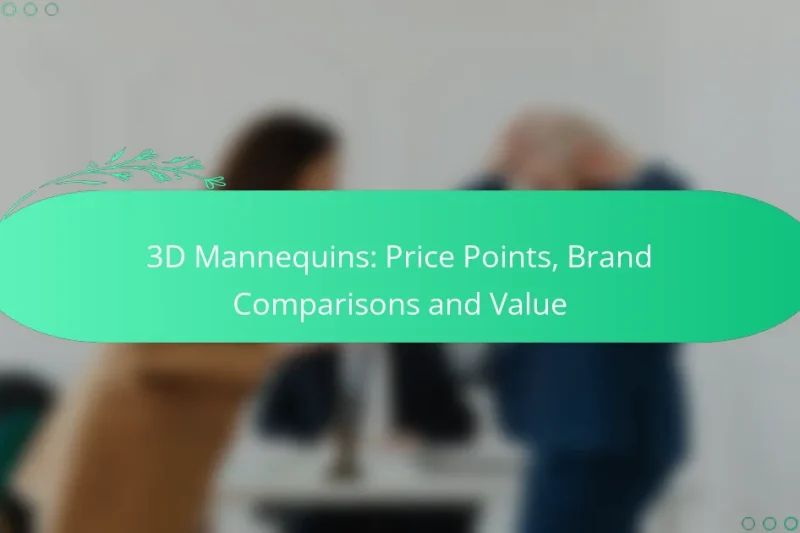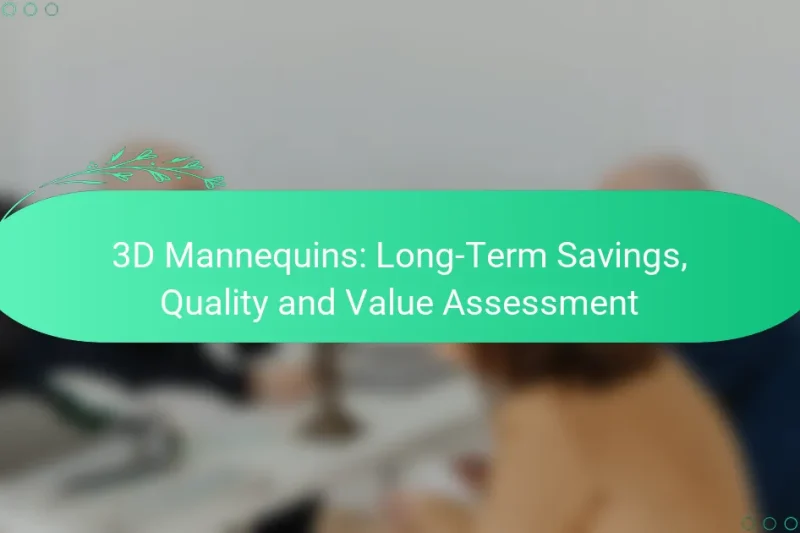When considering 3D mannequins, it’s essential to evaluate the total cost of ownership (TCO), which includes … 3D Mannequins: Total Cost of Ownership, Budgeting Insights and Price ComparisonsRead more
3D Mannequin Cost Considerations
When considering the costs of 3D mannequins, several key factors come into play, including material quality, customization options, and production methods. Prices can vary widely across different US cities, typically ranging from a few hundred to several thousand dollars based on design complexity and local demand. Although 3D mannequins may require a higher initial investment compared to traditional options, their flexibility and customization potential can lead to long-term savings for businesses.
3D Mannequins: Cost-Saving Strategies for Small Retailers
Small retailers can significantly cut costs by utilizing 3D mannequins, which help reduce shipping expenses and … 3D Mannequins: Cost-Saving Strategies for Small RetailersRead more
3D Mannequins: Financing Options and Purchase Strategies
Acquiring 3D mannequins can be streamlined through various financing options such as leasing, installment plans, and … 3D Mannequins: Financing Options and Purchase StrategiesRead more
3D Mannequins: Price Points, Brand Comparisons and Value
3D mannequins are an essential tool in the retail and fashion industries, with prices ranging from … 3D Mannequins: Price Points, Brand Comparisons and ValueRead more
3D Mannequins: Long-Term Savings, Quality and Value Assessment
3D mannequins represent a forward-thinking investment for retailers, offering long-term savings through reduced production, shipping, and … 3D Mannequins: Long-Term Savings, Quality and Value AssessmentRead more
3D Mannequins: Budgeting Essentials for Retailers
Budgeting for 3D mannequins is essential for retailers aiming to enhance their visual merchandising while managing … 3D Mannequins: Budgeting Essentials for RetailersRead more
3D Mannequins: Cost-Benefit Analysis and Investment Insights
3D mannequins are revolutionizing the retail landscape by providing enhanced customer interaction and improved product visualization, … 3D Mannequins: Cost-Benefit Analysis and Investment InsightsRead more
What factors influence 3D mannequin costs in the US?
Several factors significantly impact the costs of 3D mannequins in the US, including material quality, customization options, brand reputation, production methods, and shipping and handling. Understanding these elements can help businesses make informed decisions when budgeting for their mannequin needs.
Material quality
The quality of materials used in 3D mannequins directly affects their price. Higher-quality materials, such as durable plastics or advanced composites, tend to cost more but offer better longevity and realism. Conversely, lower-quality materials may be more affordable but can result in a less appealing appearance and shorter lifespan.
When selecting materials, consider the intended use of the mannequin. For example, mannequins used for high-end retail displays may require premium materials to enhance visual appeal, while those for internal training purposes might prioritize cost-effectiveness.
Customization options
Customization options can significantly influence the cost of 3D mannequins. Tailored features such as specific poses, skin tones, or clothing styles can increase the price, as they require additional design and production efforts. Basic models with standard features are generally more affordable.
When evaluating customization, assess your specific needs. If a standard mannequin suffices, it may be more economical to choose a less customized option. However, for unique branding or marketing strategies, investing in customization could enhance your overall presentation.
Brand reputation
The reputation of the manufacturer can play a crucial role in pricing. Established brands with a history of quality and reliability often charge a premium for their products. These brands may offer better customer service, warranties, and product support, which can justify the higher costs.
Research various brands and read customer reviews to determine if the price difference is warranted. Sometimes, lesser-known brands may provide comparable quality at a lower price, making them a viable alternative.
Production methods
Production methods can vary widely and affect costs significantly. Traditional manufacturing processes may be less expensive but can limit design flexibility and speed. In contrast, advanced techniques like 3D printing allow for rapid prototyping and customization but may come with higher initial costs.
Consider the trade-offs between cost and production speed. If time is a critical factor, investing in faster production methods may be worth the additional expense, especially for time-sensitive projects.
Shipping and handling
Shipping and handling costs can add a substantial amount to the overall price of 3D mannequins. Factors such as the size and weight of the mannequin, shipping distance, and chosen carrier can all influence these costs. It’s essential to factor in these expenses when budgeting.
To minimize shipping costs, consider ordering in bulk or choosing local suppliers. Additionally, inquire about shipping options and potential discounts that may be available for larger orders to help manage expenses effectively.
What are the average costs of 3D mannequins in major US cities?
The average costs of 3D mannequins can vary significantly across major US cities, influenced by factors such as design complexity, material quality, and local market demand. Generally, prices range from a few hundred to several thousand dollars, depending on these variables.
New York City pricing
In New York City, the cost of 3D mannequins typically starts around $1,000 and can go up to $5,000 or more for high-end models. The city’s vibrant fashion scene drives demand, leading to higher prices for customized designs.
When purchasing in NYC, consider local suppliers who may offer unique styles that cater to the fashion industry. Additionally, shipping costs can be substantial if ordering from outside the city.
Los Angeles pricing
Los Angeles offers a range of 3D mannequin prices, generally between $800 and $4,000. The entertainment and fashion industries in LA contribute to a diverse selection of mannequins, including those designed for specific promotional events.
Buyers should explore options at local trade shows or fashion expos, where they can find competitive pricing and unique designs. Be mindful of potential shipping fees if sourcing from distant suppliers.
Chicago pricing
In Chicago, 3D mannequins are priced from approximately $700 to $3,500. The city’s retail market is robust, providing various options for both standard and custom mannequins.
Consider reaching out to local manufacturers for bulk orders, as they may offer discounts. Additionally, check for seasonal sales that can significantly reduce costs.
Miami pricing
Miami’s pricing for 3D mannequins typically ranges from $600 to $3,000. The city’s unique cultural influences can lead to creative designs that appeal to diverse markets.
When shopping in Miami, look for local artisans who specialize in custom mannequins. This can provide an opportunity for unique pieces that stand out in retail displays.
How do 3D mannequin costs compare to traditional mannequins?
3D mannequins generally have a higher initial cost than traditional mannequins, but they offer significant advantages in flexibility and customization. While traditional mannequins can range from affordable to expensive, 3D mannequins often require a larger upfront investment but can lead to cost savings over time.
Initial investment differences
The initial investment for traditional mannequins can vary widely, typically ranging from $50 to several hundred dollars each, depending on materials and design. In contrast, 3D mannequins can start from a few hundred dollars and go up to several thousand, especially if custom designs are involved. Businesses should consider their budget and the specific needs of their display strategy when choosing between the two.
Long-term savings
3D mannequins can lead to long-term savings due to their reusability and adaptability. Unlike traditional mannequins, which may need to be replaced or modified for different displays, 3D mannequins can be easily updated or redesigned digitally, reducing the need for new purchases. This flexibility can save retailers significant amounts over time, especially if they frequently change their displays.
Maintenance costs
Maintenance costs for traditional mannequins can include repairs, cleaning, and storage, which can add up over time. 3D mannequins, while initially more expensive, often require less physical maintenance since they can be managed digitally. However, businesses should factor in potential software costs and any updates needed for 3D modeling as part of their overall maintenance budget.
What are the key considerations when budgeting for 3D mannequins?
When budgeting for 3D mannequins, consider factors such as project scope, market trends, and potential return on investment. Each of these elements can significantly impact the overall cost and effectiveness of your investment in 3D mannequin technology.
Project scope
The project scope defines the extent of your 3D mannequin needs, including the number of mannequins, level of customization, and intended applications. A larger project with more complex requirements will naturally incur higher costs. For instance, creating a single, highly detailed mannequin may cost less than a series of mannequins designed for various poses and styles.
Additionally, consider whether you need physical mannequins or digital versions for virtual environments. Digital mannequins may offer lower upfront costs but could require ongoing software expenses or subscriptions.
Market trends
Staying informed about market trends is crucial for making a sound investment in 3D mannequins. The demand for realistic and customizable mannequins is increasing, driven by advancements in technology and consumer preferences. Prices can vary based on these trends, so monitoring industry reports and competitor offerings can help you budget effectively.
Furthermore, emerging technologies such as augmented reality (AR) and virtual reality (VR) are influencing how mannequins are used in retail. Investing in 3D mannequins that integrate with these technologies may offer a competitive edge but can also increase initial costs.
Return on investment
Evaluating the return on investment (ROI) for 3D mannequins involves considering both direct and indirect benefits. Direct benefits may include increased sales from enhanced product displays, while indirect benefits could involve improved customer engagement and brand loyalty. Estimating these returns can help justify your budget allocation.
To maximize ROI, focus on high-quality mannequins that align with your brand image and customer expectations. Conducting a cost-benefit analysis can provide insights into how different options will impact your bottom line over time.
What are the financing options for purchasing 3D mannequins?
Financing options for purchasing 3D mannequins typically include outright purchases, leasing, and financing through third-party lenders. Each option has its own advantages and considerations, depending on your budget and cash flow needs.
Outright Purchase
Buying a 3D mannequin outright means paying the full price upfront, which can range from a few hundred to several thousand dollars depending on the complexity and features. This option is ideal for businesses that have the capital available and want to avoid ongoing payments.
However, consider the impact on your cash flow. Spending a large sum at once can limit your ability to invest in other areas of your business. It’s crucial to ensure that this purchase aligns with your overall financial strategy.
Leasing Options
Leasing a 3D mannequin allows you to use the equipment without a large upfront investment. Monthly lease payments can be more manageable and often include maintenance and support, which can reduce long-term costs.
When considering leasing, check the terms carefully. Look for options that allow for upgrades or early termination if your needs change. This can provide flexibility as your business evolves.
Financing Through Third-Party Lenders
Financing through third-party lenders can be a viable option if you prefer to spread the cost of a 3D mannequin over time. Many lenders offer tailored financing solutions, including low-interest loans or installment plans.
Before committing, compare interest rates and terms from different lenders. Ensure that the total cost of financing does not exceed your budget and that the monthly payments fit within your cash flow projections.






